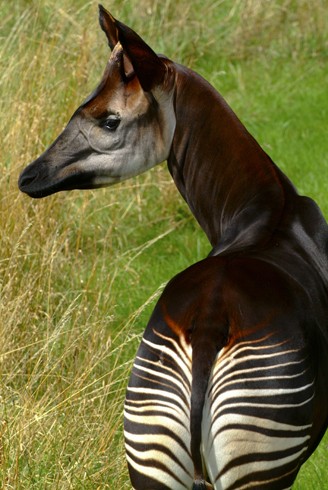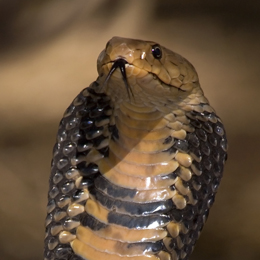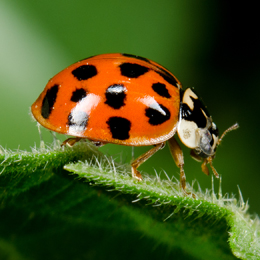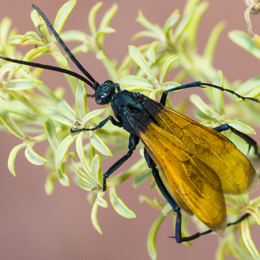Okapi
The Okapi resides in the dense tropical rainforest located northeast of the Democratic Republic of Congo. It is an elusive and shy animal that was not discovered by the outer world until 1887. The first description of this herbivorous animal was made in 1901 by a British Zoologist named Ray Lankester. The name Okapi and the generic name Okapia were derived from the word o’api which is used by the indigenous African people speaking Lese Karo language. The specific name ‘johnstoni’, however, was given in honor of the then British Governor of Uganda, Sir Harry Johnston. He was the first person from the Western world to have obtained an Okapi specimen from a dense tropical forest, called Ituri Forest.
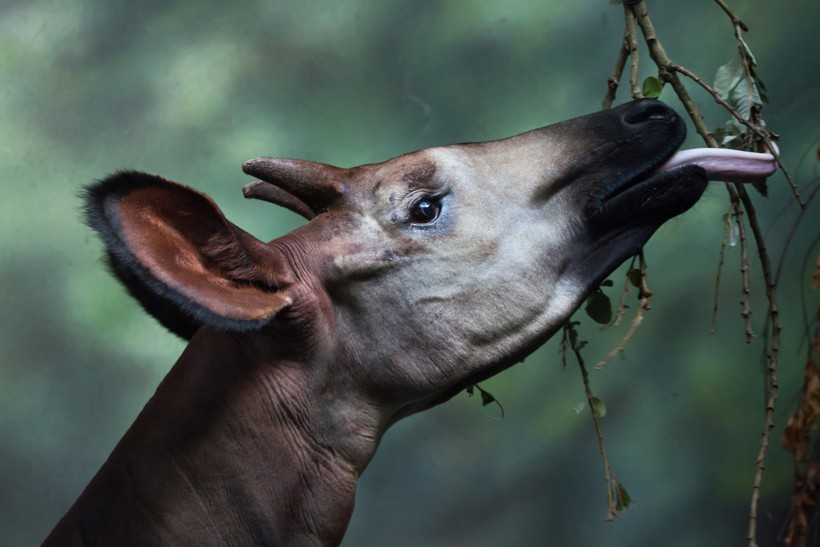
Okapis possess a long prehensile black tongue
?
Image credits: Vladimir Wrangel/Shutterstock
Even though the neck of an Okapi is relatively long in comparison to its body, its striking feature lies in the horizontal stripes on their backside that lends the animal a Zebra-like appearance. The head of a male Okapi consists of ossicones, which are short horns covered by hair, while the females possess hair whorls instead of these ossicones. This animal is shy and secretive and is seldom spotted by people living around their dense habitat.
This characteristically shy animal has an enormously long prehensile tongue which is quite similar to its tall Giraffe relative. They use this tongue for grabbing onto branches, leaves and also for grooming. In fact, the Okapi is among the few land animals that are able to clean and lick their ears with their tongue. In the wild, the lifespan of this rarely seen animal ranges from 20 to 30 years.
Okapi vs. Giraffe
The Okapi and Giraffe are the only two animal species that belong to the family of Giraffidae. Contrary to the Giraffe that has several subspecies spread all around Africa, the Okapi has no subspecies. Although the Giraffe and Okapi might seem as different as chalk and cheese regarding size and appearance, these animals have quite a few similarities that make them fall into the same family. Both animals have a long, black prehensile tongue and an elongated neck. Also similar to Giraffes, Okapis lack upper incisors. Moreover, both animals have a large palatine sinus that is unique for the giraffidae family.
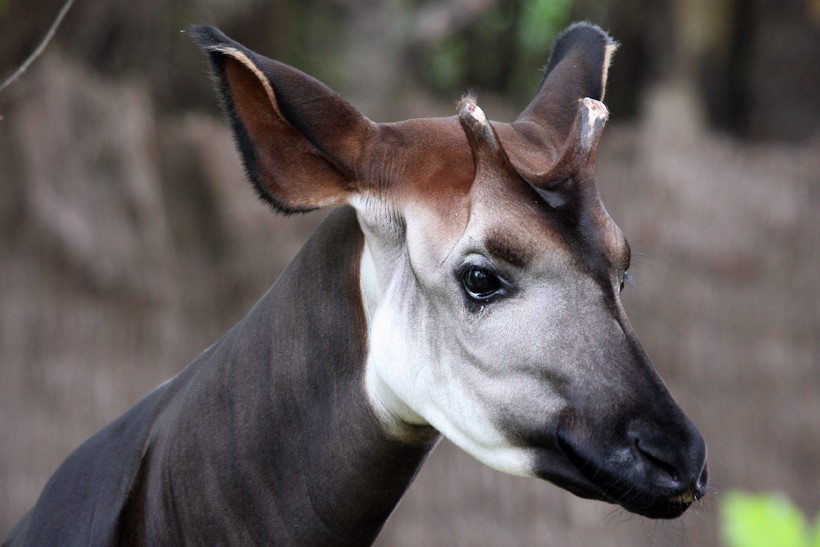
Closeup horned head Okapi
?
Image credits: MarclSchauer/Shutterstock
On the other hand, Okapi and Giraffe have quite a few differences as well. There is a striking difference in height between these two animals. The average height of Giraffe is 2.5-3 m (8 – 10 ft) whereas the maximum height of an Okapi is 1.5 m (4.9 ft). Okapis also have scent glands in their hooves which help in marking their trail in the dense forest while Giraffes don’t have such glands. Besides, horns are seen only in male Okapis while both the sexes of Giraffe bear horns.
Anatomy and Characteristics
The physical form of an Okapi superficially resembles the body of a horse. The average length of the body is 2.5 meters and its average height is 1.5 meter. The neck of Okapis are relatively long compared to other ruminants and their ears are considerably large and flexible. The color of their coat varies within different parts of their body. The primary color is reddish-brown while the hind quarters and legs are covered by white horizontal stripes that closely resemble the stripes of a Zebra. The ankles are white while the chest, throat and cheeks are either whitish-gray or tan. This unique coat pattern is an effective camouflage for these shy animals as it greatly helps them in disappearing amidst the dense vegetation of its habitat.
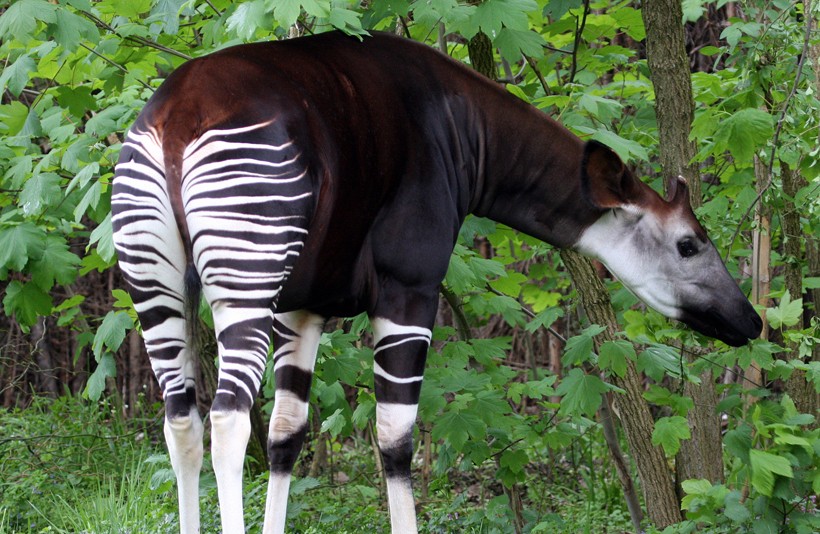
The Okapi was not discovered by the Western world until the end of 19th century.
?
Image credits: MarclSchauer/Shutterstock
The feet of this animal has interdigital glands or scent glands with their size being larger at the front feet. The head of male Okapis have small hair-covered horns or ossicones that are hardly 15 cm in length. There is sexual dimorphism among this species with females Okapis being marginal taller than males and displaying a slightly redder coat. Unlike the male Okapis, females of this species lack the ossicones and possess hair whorls instead.
The body of this animal has adapted well to the tropical climate of its habitat. With their efficient olfactory system, these animals are equipped with a keen sense of smell. They also have a powerful night vision which is facilitated by plenty of rod cells present in their retina.
The low-crowned and fine-cusped teeth play an important role to cut tender foliage. Moreover, the large caecum in combination with the large colon greatly helps the Okapis in microbial digestion compared to other ruminants.
Habitat
Okapis are primarily found in the north-eastern part of the Democratic Republic of Congo which is mainly covered by dense tropical rainforest. They generally inhabit areas at an altitude between 500 and 1000 m whereas the majority of these individuals are seen in the areas around 800 m above sea-level. Being a very shy and elusive creature, Okapis depend on the thick foliage of the rainforest for protecting itself from its predators. However, they are also found in areas with a freshwater source running slowly on its trail. The home range of these remote animals is limited as unsuitable habitats acting as natural barriers, thereby trapping the animal within a range of 63,000 square kilometers of the Ituri Rainforest. At present, a major portion of this rainforest is covered by Okapi Wildlife Reserve that is also recognized as a World Heritage Site. Although Okapis are pretty common within their native region, their survival is threatened by loss of habitat that usually takes place because of unrestrained deforestation.
Diet & Predation
Diet
Okapis are diurnal animals that forage along fixed and well-trodden paths throughout their dense forest habitat. As herbivores, their primary food involves leaves, buds, twigs and shoots of around 100 different plant species available in their home range. Incidentally, it has also been noticed that a number of plants that contributes to the diet of Okapis can be extremely poisonous to humans. Additionally, these animals feed on grasses, ferns, fungi and fruit. In fact, an examination of their feces revealed that okapis consume charcoal formed as a result of trees being burnt by lightning. Different field observations suggest that they fulfill the requirement of minerals and salt by licking the sulfurous, slightly salty and reddish clay found along the rivers and streams.
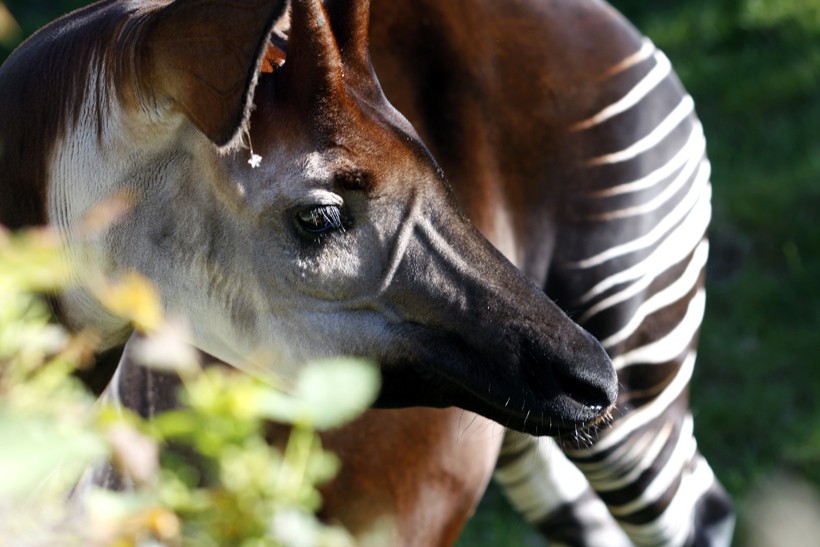
The Okapi is found in the dense forest that is spread all across Central Africa
?
Image credits: Igor Matic/Shutterstock
Predation
As the species of Okapi is concentrated in the secluded regions of dense mountain rainforest, it is predated by only a few animals as compared to other herbivores. The primary predator of this elusive animal is the Leopard, one of the most powerful felines. Due to the acute sense of hearing that Okapis possess, they easily sense the presence of other animals that moves through the forests’ undergrowth. However, as the Leopard spend most of its time resting in trees and usually ambush its prey from above the ground, Okapis easily fall prey to the Leopard’s agile hunting tactics. Additionally, Okapis are occasionally predated by Servals, which are medium-sized wild cats found in Africa. Humans also hunt this animal for sports and skin in case they emerge from their remote habitat and comes across human settlement. However, besides predation, the biggest threat to the population of Okapi is habitat loss caused by deforestation.
Reproduction and Life Cycle
Okapis usually lead a solitary life with males and females coming together briefly only for the purpose of mating. The female Okapis attain sexual maturity after about 18 months while males become sexually mature after about two years. These animals have no specific season for mating as estrus in females and rut in males can occur at any time of the year. In captivity, the females went through estrus cycles every 15 days.
According to an observation made on Okapis under captivity, the courtship starts when the male and female circle, sniff and lick each other. The male then starts asserting his dominance by thrusting his front leg forward towards the female Okapi, a behavior that is also accompanied by extending the neck and head-tossing. After a brief exhibition of this peculiar courtship, the male Okapi would finally mount on the female and start copulating. After mating, these two animals do not stay together and move on towards their separate ways.
The gestation period can range from 440 to 450 days. Female Okapis give birth to a single calf as there has been no record of Okapis giving birth to twins. Two months prior to parturition, the pregnant Okapi’s udder starts swelling which is accompanied by a vulval discharge. During parturition, which lasts for 3 – 4 hours, the female remains standing for the most part of it.
The newborn calves weigh around 14 – 30 kgs (31 – 66 lbs) and are born with false eyelashes along with their long dorsal mane and white hairs covering the stripes. These features, however, disappear gradually and their final appearance set in within a year. Similar to other ruminants, the young of Okapis is able to stand on its feet within just 30 minutes from taking birth and follows its mother on feet. Female Okapis tend to groom their infants extensively and their milk has a very high protein and low-fat content which is vital for the calves’ fast growth. The young Okapi spends the first couple of days by following the mother and exploring the surrounding environment. Thereafter, both mother and young make a nest at a suitable hidden spot where they spend over 80 % of their time for the following two months. This hiding behavior protects them from predators and also allows the calf to grow rapidly. During this hidden stage, they avoid defecating as part of their strategy to keep themselves undetected by predators.
In the case of danger, a female Okapi aggressively defends her calf while the calf keeps itself motionless in the nest. The young solely live on mother’s milk at the beginning but start taking solid food in small amounts after three months. The weaning period is about six months, but the calf may keep on suckling for a year. Young males develop their ossicones after one year and both the sexes reach their adult size after about three years of age.
Behavior, Communication and Intelligence
Okapis are diurnal animals that remain active during the day. These creatures spend a major portion of the day roaming through the forest on their set paths in search of food. However, depending on the season and circumstances, Okapis might remain active for a specific period of time in darkness. Characteristically, these animals are solitary and come together only for breeding.
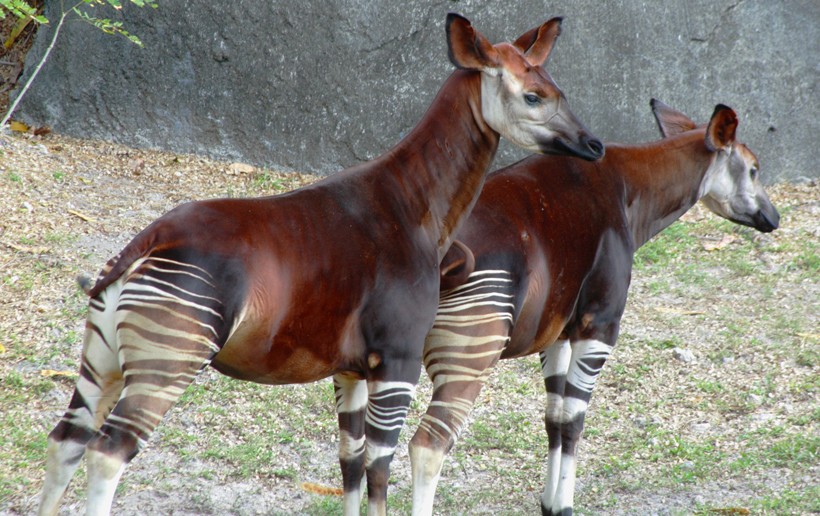
Pair of Okapi
?
Image credits: Felix Mizioznikov/Shutterstock
The home range of different Okapis often overlaps each other and their typical density is calculated to be 0.6 animals per square kilometer. The home range of male Okapis occupies an average area of 13 square kilometers (5 square miles) while in the case of females, this is only 5 square kilometers (2 sq. miles). Males of this species migrate continuously but female Okapis tend to lead a sedentary life. These animals display a territorial nature and both sexes mark their territory, but in a slightly different manner. The males usually mark their home range with their urine whereas the females prefer to use the common defecation site. Sometimes, both male and female Okapis rub their neck against trees and leave a brown exudate as a mark of their territory.
Even though male Okapis tend to become very protective of its territory, it often allows female Okapis to pass through their home range for foraging. Males, on the other hand, visit female territories for breeding. Although Okapis are primarily passive by nature, they can exhibit aggression by kicking and butting with their heads. Because of their poorly developed vocal cords, the vocal communication of Okapis is limited to just a few different sounds. Both males and females use ‘chuff’ for contacting each other during breeding time and sometimes the female Okapis moan during courtship. The infant might bleat to contact its mother if it comes under stress. Some individuals also use visual expression known as Flehmen response which is carried out by displaying the teeth and curling back the upper lips and inhaling through the mouth briefly.
Population and Conservation
The Okapi is found in the dense forest that is spread all across Central Africa in the Northern and Eastern regions of the Democratic Republic of Congo and also along the northern and eastern part of the river Congo. The primary habitat area of this species stretches northward from the Maiko forest all the way to Ituri forest and along the river basins of Lake Tele, Rubi, Ebola and Ubangi River. Additionally, smaller populations of Okapis are also found in the Epulu and Wamba area while they are extinct in Uganda.
The Okapi has been classified as an Endangered Species by the IUCN. This animal is strictly protected under the Congolese Law. There is a significant population of this animal in Okapi Wildlife Reserve and the Maiko National Park but their number is steadily declining in these areas due to a number of reasons. Besides these areas, Okapis occur commonly in the Abumombanzi Reserve as well as in the Rubi Tele Hunting Reserve. The major threat that contributes to the declining population of this mysterious animal is habitat loss caused by human settlement and logging. Moreover, excessive hunting of Okapis for bush-meat and their unique skin combined with illegal mining also make a significant contribution towards their declining numbers. Although there are no exact data, the number of individuals of this elusive herbivore has been estimated to range from 10,000 to 35,000.
Established in 1987, the Okapi Conservation Project primarily works for bringing the population of Okapis to a stable number and also helping the indigenous Mbuti people that live around their habitat to experience growth and prosperity. With proper conservation techniques and prevention of illegal hunting of this unique creature, there is a possibility to increase the number of these shy animals rapidly.
Evolutionary History
The ancestors of Giraffidae first appeared as a result of a diversion from Climacoceratids, a superficially deer-like creature that roamed Africa during the Early Miocene. A number of important primitive giraffids like Samotherium, Palaeotragus, Canthumeryx and Giraffokeryx also appeared contemporaneously during the Miocene around 10 – 23 million years ago (myg). According to Paleontologist Kathleen Hunt, the nowadays Okapi directly evolved from the giraffid Samotherium around 18 myg after which it split into Okapia and Giraffa (12 myg) consecutively. However, it has been argued by author J. D. Skinner that Okapi and Giraffe evolved from Canthumeryx and this mysterious creature is, in fact, an extant form of species of Palaeotragus. Moreover, due to the resemblance of Okapis with a number of primitive forms of animals that existed earlier, this animal is often called a Living Fossil.
Funfacts
- Okapis have an impressively long prehensile tongue that is black in color.
- Similar to Giraffes, Okapis use their long tongue to clean their ears.
- The Giraffe is the only living relative of Okapis although they resemble the body structure and coat of a Zebra.
- The Okapi was not discovered by the Western world until the end of 19th century.
- Okapis are very elusive and shy creatures that are rarely seen by people.
- Due to their preference to stay within dense tropical rainforest and the presence of Zebra like stripes on their body, Okapis are also referred as Forest Zebra.
- Okapis have an acute sense of hearing and a very good night vision.
